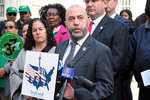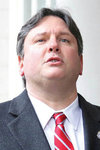A few of our stories and columns are now in front of the paywall. We at The Chief-Leader remain committed to independent reporting on labor and civil service. It's been our mission since 1897. You can have a hand in ensuring that our reporting remains relevant in the decades to come. Consider supporting The Chief, which you can do for as little as $3.20 a month.



The Fire Department’s decision to deploy 68 Emergency Medical Service Trainees on New Year’s Eve, perhaps the busiest tour of the year, proves the city has a serious EMT shortage that puts the public’s well-being at risk and drives up response times, according to the unions that represent the EMS workforce.
“The FDNY is running with dozens upon dozens of ambulances off-line each tour due to the fact that 900 of our members left our service to become firefighters just in the past year,” Oren Barzilay, president of District Council 37’s Local 2507, said in a phone interview. “And that’s not including the dozens upon dozens of our members that just left for the NYPD. They’re leaving faster than the FDNY can hire replacements.”
30% Short on EMTs?
Mr. Barzilay estimated that the EMS is 30 percent below its authorized headcount for Emergency Medical Technicians.
“People in New York City will die due to an ambulance and supervisor staffing shortage created by the FDNY,” said Vincent Variale, president of DC 37’s Local 3621, which represents the EMS officers.
Deputy Fire Commissioner Francis Gribbon said in an email exchange that New Year’s Eve’s deployment went well and that New Year’s Day was busy, with close to 4,600 assignments citywide. He added that the trainees were supplemental personnel who “were not performing primary care—rather, their presence was more a training experience that we have often used over the years on expected busy periods, whether New Year’s Eve or during an expected citywide emergency like a snowstorm or hurricane.”
Mr. Gribbon said that the department’s biggest impediment to full EMT staffing was a lack of space and teaching staff. “We only have capacity to train 180 Probationary EMTs at a time due to space and staffing, and the New York State Dept. of Health has a student-to-instructor ratio requirement,” he said. “The main issue is space at Fort Totten. In anticipation of promotions to Firefighter last year, we went more than 500 over budgeted headcount for EMTs. We will graduate approximately 180 new EMTs later this month, and expect to get back to full headcount in the next few months.”
Point to Pay Gap
Mr. Barzilay and Mr. Variale have testified on multiple occasions before the City Council that it is the EMS pay scale, which is tens of thousands of dollars lower than for Firefighters, that is responsible for the shortage because it builds in an incentive for their members to seek a “promotion” to firefighting, and even to the NYPD, as soon as they are eligible.
“We are now in a situation where New York City fast-food workers can make $15 an hour but a starting EMT’s pay is just $16 an hour,” said Mr. Barzilay. “I am not taking anything away from fast-food workers, ’cause they sure deserve it, but our members hold people’s lives in their hands; we bring people back to life. Where’s the logic with that?”
“When it comes to retention, the problem lies with the lack of pay and promotion opportunities for EMTs,” said Council Member Joseph Borelli, chair of the Council’s Fire and Emergency Management Committee. “If those opportunities existed throughout the EMS ranks, we would not be holding our breath every time there is a promotions class and we have to brace for the exodus of talent.”
He will hold an oversight hearing Jan. 14 to take a closer look at city emergency-response times.
According to the latest edition of the Mayor’s Management Report, response times to life-threatening medical emergencies for city ambulances averaged 7:17 for the most-recent fiscal year measured, as compared to 6:34 for the previous fiscal year.
Average response times to the same kinds of medical emergencies by fire units also went up, but only by four seconds, according to the MMR. The most recent report showed fire-engine medical-emergency response times were averaging 4:43, compared to 4:37 for the previous fiscal year.
'City Falling Short'
Last year the Citizens Budget Commission, a non-profit, pro-business public finance monitor, reported that when it came to responding to those most-serious medical calls, the city had been losing ground in recent years.
“The City is falling short of a National Fire Protection Association benchmark that response to an incident requiring Advance Life Support care should be by an ALS ambulance within 9 minutes at least 90 percent of the time,” according to the CBC. “The FDNY historically has held itself to a lower standard of ALS response of 10 minutes 90 percent of the time; according to the FDNY, in 2017 only 57.6 percent of ALS responses to ALS incidents met that benchmark. In fiscal year 2011 this figure was significantly better at 80.5 percent.”
Dr. Kevin Munjal, a New York City-based Emergency Medical Service specialist and author, maintains that the Mayor and City Council should be concerned about the perennial churn of talent out of the EMS workforce.
What's Needed
“I think how dedicated and professionally committed they are in terms of building a medically-centered career really matters for patient outcomes, both for today, and in the future,” he said. “You want a pre-hospital care system that is always improving and innovating…comprised of skilled health-care providers…constantly pursuing knowledge and seeking out additional experiences to improve their abilities to perform critical assessments and life-saving interventions for the people of our city.”
We depend on the support of readers like you to help keep our publication strong and independent. Join us.
Comments
No comments on this item Please log in to comment by clicking here